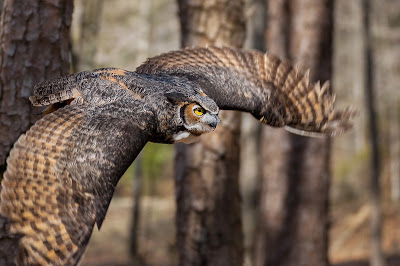As 2014 is drawing to a close it is once again time for me to select my top ten images of the year. This exercise has become an important part of my photographic tradition and process as it helps me to see where I have been over the last year and how much, if any, I have progressed. This year has given me several fun and interesting opportunities to photograph birds and that will be reflected heavily in my selected images. Once I considered myself more interested in landscape photography but now I am moving quickly into becoming a wildlife photographer. The beauty that God has placed into these creatures is beyond amazing and I love to capture that beauty whenever possible.
#1 - Great Horned Owl in Flight. If you have followed me at all you have seen this image plastered all over my social media and public web site. I love this image because it represents first, my favorite raptor species and second because it is in a wooded environment in flight as it normally would be seen in the wild. The out of focus feathers in the foreground and background help to emphasize motion and speed.
#2 - Cardinal in Golden Light. Late afternoon light is my favorite type of lighting for almost any natural subject. Here, a male northern cardinal faces the golden western light pouring in just before the sun falls below the tree line.
#3 - Tribute. Perhaps this image is tied too much into my own sentimentality of the great memories of going fishing with my grandfather and brother, but I do find this an interesting departure from my normal subjects. I went black and white with a touch of sepia in the final image.
#4 - Eagle in Quarter Pose. This eagle decided to give me a bit of a show so I took full advantage of it. She has a very intimidating and proud look which is accented by her wings spread out just as one would expect to see on the back of the US quarter or as seen in ancient Roman culture. It is no wonder so many cultures use the eagle as a symbol of strength and courage.
#5 - Pine Forest. This is a photo that appeals to me at both an artistic level and as a symbol of North Carolina, my current home. At an artistic level, I love the symmetry of the pine trees and the converging lines which they create. In the distance the converging trees disappear into early morning fog giving the scene a sense of mystery. On the practical or historic side of the equation, these trees reflect the nature of the forests throughout North Carolina which are in some areas completely covered with various pine trees.
#6 - Indigo Bunting. The bunting makes number six in my list not because it is an awesome composition or that I performed some amazing work of photography, but because of the mind numbing beauty of this species. What an amazing work of God to produce such an stunning, iridescent bird. In fact this bird has no blue pigment in its feathers but when the sun strikes the feathers it reflects blue due to iridescent qualities in the feathers themselves. Note how quickly the shadow falls to black on the shadow side of the bird because the single light source shining in at such an acute angle cannot produce the same level of iridescence in the feathers.
#7 - Titmouse in the Snow. The gregarious titmouse is one of my favorite songbirds and here it is shown perched in a rare North Carolina snow "storm."
#8 - Mississippi Kite. This images appeals to me because this raptor appears almost ghost like as the sun pours through its open wings. I used fill flash to compensate for the loss of light on the side of the bird facing the camera.
#9 - Short Eared Owl. This image was taken as part of a fund raising event at a local raptor rehabilitation center, but I like it first because it has an almost studio like portrait feeling which is not often attained shooting wildlife and secondly because it is a species that would be impossible for me to photograph in North Carolina. The cattails lend to the notion that this bird is a ground species of owl.
#10 - Chilean Flamingo. It was a tough call to make between this image and the red-bellied woodpecker but in the end it came down to liking the flamingo based on art rather than color. Although the flamingo is a very colorful bird I like this image first because the neck of this bird forms an almost perfect "S" shape and second because of the eye peaking out behind it's fluffed out feathers.
Well, that's it for 2014 and I enjoyed it to the fullest! Thanks to my family and for putting up with my at times obsessive hobby. Keeping photography balanced with my relationship with God and family remains a challenge and I will continue to improve that balance within the coming year. There is more to come in 2015, Lord willing and the creek don't rise. Have a happy new year!















.jpg)











